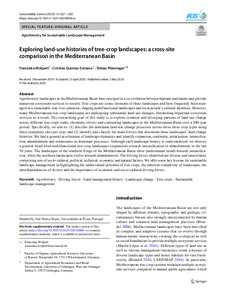| dc.date.accessioned | 2020-09-01T09:58:55Z | |
| dc.date.available | 2020-09-01T09:58:55Z | |
| dc.date.issued | 2020-05-02 | |
| dc.identifier | doi:10.17170/kobra-202008251634 | |
| dc.identifier.uri | http://hdl.handle.net/123456789/11748 | |
| dc.description.sponsorship | Gefördert im Rahmen des Projekts DEAL | ger |
| dc.language.iso | eng | eng |
| dc.rights | Namensnennung 4.0 International | * |
| dc.rights.uri | http://creativecommons.org/licenses/by/4.0/ | * |
| dc.subject | agroforestry | eng |
| dc.subject | driving forces | eng |
| dc.subject | land management history | eng |
| dc.subject | landscape change | eng |
| dc.subject | tree crops | eng |
| dc.subject | sustainable landscape management | eng |
| dc.subject.ddc | 580 | |
| dc.subject.ddc | 630 | |
| dc.title | Exploring land-use histories of tree-crop landscapes: a cross-site comparison in the Mediterranean Basin | eng |
| dc.type | Aufsatz | |
| dcterms.abstract | Agroforestry landscapes in the Mediterranean Basin have emerged in a co-evolution between humans and nature and provide numerous ecosystem services to society. Tree crops are iconic elements of these landscapes and have frequently been managed in a sustainable way over centuries, shaping multifunctional landscapes and local people’s cultural identities. However, many Mediterranean tree-crop landscapes are undergoing substantial land-use changes, threatening important ecosystem services as a result. The overarching goal of this study is to explore common and diverging patterns of land-use change across different tree crops (oaks, chestnuts, olives) and contrasting landscapes in the Mediterranean Basin over a 200-year period. Specifically, we aim to: (1) describe the dominant land-use change processes across these three crop types using three exemplary sites per crop; and (2) identify and classify the main drivers that determine these landscapes’ land change histories. We find a general acceleration of landscape dynamics and identify expansion, continuity, polarisation, intensification, abandonment and renaissance as dominant processes. Although each landscape history is contextualised, we observe a general trend from multifunctional tree-crop landscapes (expansion) towards intensification or abandonment in the last 70 years. The landscapes of the southern fringe of the Mediterranean Basin show predominant trends towards intensification, while the northern landscapes evolve towards abandonment. The driving forces identified are diverse and interrelated, comprising sets of socio-cultural, political, technical, economic and natural factors. We offer some key lessons for sustainable landscape management in highlighting the undervalued potential of tree crops, the inherent complexity of landscapes, the interdependencies of drivers and the importance of economic and socio-cultural driving forces. | eng |
| dcterms.accessRights | open access | |
| dcterms.creator | Wolpert, Franziska | |
| dcterms.creator | Quintas-Soriano, Cristina | |
| dcterms.creator | Plieninger, Tobias | |
| dc.relation.doi | doi:10.1007/s11625-020-00806-w | |
| dc.subject.swd | Agroforstwirtschaft | ger |
| dc.subject.swd | Bodennutzung | ger |
| dc.subject.swd | Geschichte | ger |
| dc.subject.swd | Landschaftsentwicklung | ger |
| dc.subject.swd | Baumbestand | ger |
| dc.subject.swd | Eiche | ger |
| dc.subject.swd | Kastanie | ger |
| dc.subject.swd | Ölbaum | ger |
| dc.subject.swd | Landespflege | ger |
| dc.subject.swd | Nachhaltigkeit | ger |
| dc.subject.swd | Mittelmeerraum | ger |
| dc.type.version | publishedVersion | |
| dcterms.source.identifier | EISSN 1862-4057 | |
| dcterms.source.issue | Issue 5 | |
| dcterms.source.journal | Sustainability Science | eng |
| dcterms.source.pageinfo | 1267-1283 | |
| dcterms.source.volume | Volume 15 | |
| kup.iskup | false | |


